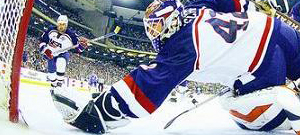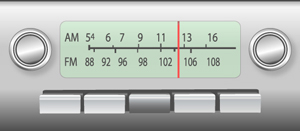The more that I read about the latest and greatest music marketing trends, the more I want to stand up on my desk and shout “don’t go over the cliff with the rest of the lemmings!” But, given the current hype and the herd mentality that artists usually exhibit, twenty-four months from now 5,000,000 artists will be using Twitter and fan relationship management tools to attempt to acquire fans and/or to boost average-revenue-per-fan (ARPF). When I think of the prospects of millions of artists traveling down this road, ARPF is exactly what I want to do. Three years from now, most artists will be disappointed and a new crop of artists will be jumping off a different cliff altogether (remember the MySpace cliff?).
The famous hockey player Wayne Gretzky once said: “A good hockey player plays where the puck is; a great hockey player plays where the puck is going to be.” In this post I want to uncover the obstacles to self-promoting music and suggest an alternate path that will take you where the puck is going to be.
Self-promotion obstacle one - online fragmentation
The Internet is not one big homogeneous, connected web of word-of-mouth amplifiers. The reality is, music consumers are frequenting a hundred different disparate sites and they are engaging with music in a myriad of ways. An artist is extremely fortunate if he or she can attract a large audience within one or more of these online fragments at a time. Great songs do go unheard. Don’t buy into the hype/myth that putting your songs into ten online stores and upon fifteen social networks matters. It doesn’t. Consumers need filters and the imprinting that results from radio-like repetition.
Self-promotion obstacle two - geographic fragmentation
The English-speaking world is comprised of over 1.6 billion people. The fragments that may enjoy your brand of music are going to be spread out all over this world. The combination of online fragmentation combined with geographic fragmentation is a matrix of target and reach challenges that’s extremely difficult to overcome given the promotion budgets of independent artists.
Self-promotion obstacle three - the need to obtain multiple impressions
Once you have sorted out the fragmentation obstacles you have to start thinking about obtaining multiple spins for your song or video. Depending on the song, after a certain number of spins and/or live appearances, some X percentage of listeners may become fans; chances are it’s going to take more than one spin. Previously, it was easy for music marketers when radio was the biggest source of repetition; now spins have to be had within a variety of devices (iPods, cell phones, laptops, etc.) and upon a variety of ‘radio’ options (terrestrial, internet, satellite, cable TV and wireless).
At this point in the post, visualize the multi dimensional music promotion matrix that includes online fragmentation, geographic fragmentation, network fragmentation, device fragmentation, consumer preferences, and consumer behavior.
Self-promotion obstacle four - delivering the right online value proposition
A value proposition answers the question: “What does this product or service do for me?” Does the product make me smart? Does the product make me sexy? Does the product make me healthy? What does your music-related website do for me? For 99.9999% of all artists, the answer to that question is: your website informs me and that’s it. Your site tells me: who you are, where your next show is, what you look and sound like, how to obtain your music, and how to purchase your tickets or merch. What you site probably fails to do, is to truly entertain ‘me’ (as in consumers).
A playlist filled with your songs, two of your videos and pictures of your cat is not entertainment that can compete with all of the other forms of online entertainment, and it’s probably not entertainment that you can build a sustainable, product-shucking, cash-generating brand upon. To begin to solve the puzzle of obtaining multiple impressions on a low budget from a highly fragmented and geographically dispersed target audience comprised of overloaded consumers that don’t want to spend more than .99 cents for a song, you are going to have to grow beyond ‘informs me’ to deliver ‘entertains me’ and more.
Self-promotion obstacle five - overloaded consumers
Five years ago, in any given marketplace the impressions (the spins) were simply delivered through five to seven competing radio stations featuring separate to overlapping genres of music. Now, not only have the listening options expanded, every kid with an electric guitar and a TuneCore account is promoting music. Self-promotion will not scale; there are not enough receptive consumers to absorb the marketing messages or to take on the spins that are needed to convert listeners into fans for all the artists attempting to do so. When three million artists start pounding out emails, tweets and fan management action items, the whole lot of you will start to seem like stockbrokers at a cocktail party. 
Self-promotion obstacle six - minimal ROI
Dollars that were once earned from three to four revenue sources are now pennies earned from hundreds. Given the investment you have to sink into solving the Rubik’s promotion cube divided by the revenue you generate from all sources, the return seems hardly worth bothering over. When a million artists generate one dollar of revenue each, who makes the real money? The aggregators that collect a percentage of every dollar processed are the ones generating a reasonable return on investment; it’s certainly not artists.
Yes there are independent artists earning a sustainable living, and there may even be one or two that are making a lot of money. However, show me another industry where the gross / aggregate investment (time and money) across all of the participants generates such a negative ROI. When this industry had (past tense) a massive upside lottery component to it, the potential reward mitigated the risk. Now, if you are going to go over the dream-chasing cliff that the tech providers are currently peddling, you better be doing it for the love of your art (period).
Go where the puck is going to be…
Look at the fragmentation of the music consumption marketplace this way: genres are coastlines, niches within genres are beachfront properties, and standalone artists are rocks or grains of sand. Sticking with the metaphor: coastlines and beachfront properties are compelling, interesting and entertaining; rocks and sand are things that get stuck in your shorts and sandals.
IMPORTANT - the competition for consumer mindshare (when it comes to music consumption) is going to be fought on the battlefield where the war is over which ‘channel’ can deliver the most compelling entertainment (underline) to any given market segment. Moving forward, trusted entertainment channel providers - filters that can continuously find great songs for a niche - will have access to consumers as surely as consumers desire to gain access to the beach; alternatively, attempts by standalone artists to ‘manage’ relationships with fans will be as welcome as sand in a sandwich. 
Pick a niche, band together, form a channel, attack radio…
Radio stations and the radio industry are vulnerable right now. The radio spectrum, the broadcast antennas and the satellites that define traditional radio are becoming an expensive liability (think debt service and operating costs). More and more consumers are switching to online listening (internet, iPhone, etc) as the preferred method to consume ‘radio’ programming. When this happens (and it’s happening) there’s really NOTHING that a conglomerate of artists can’t do FAR better.
Better than radio…
When it comes to being the ‘channel’ that can deliver the most compelling online entertainment (to a targeted niche) radio stations can’t compete with an organization of artists and/or rightsholders working together (referred to as ‘you’ from this point onward). Here are just some of the distinct advantages ‘you’ have:
Advantage one - the cost advantage. Radio stations have legacy costs (mentioned above), they have to pay royalties and they have high (relative to you) operating costs. You can put together an operational and a legal structure where all your costs are far less. Moreover, you are probably going to be selling your own product (music, tickets, merch, ringtones), which means you don’t have to attract numerous annoying advertisers (ads are annoying); just one or two sponsors will probably suffice.
Advantage two - the entertainment advantage. Just streaming music is yesterday’s entertainment. Broadband speeds are expected to rise substantially over the next few years, which will increase demand for all forms of high definition audio and visual content. Your ability to provide hours of HD video and thousands of relevant images (think high resolution, flat panel wallpaper coupled to music) blows away what a radio station can provide; moreover you own it, radio doesn’t.
Advantage three - the niche advantage. Radio stations stock their playlists to satisfy the widest possible segment within a genre; it’s the most common denominator approach that mass-market media outlets always pursue. This won’t work on the Internet. The Internet is about sub-segments, fragments and niches. You can splinter a radio station’s audience by promoting a superior entertainment product to a sub-segment of listeners.
Advantage four - the personality advantage. You are not bound by the restrictions placed on radio and you are not (should not be) confined to the traditions and practices that define the personality of radio; you can be something completely different. Furthermore, the local radio station jock is a middleman between you and your fans. Within your online community, you (collectively) can supply highly relevant, direct, continuous and simultaneous interaction.
Advantage five - the promotion advantage.
Take away radio’s satellites and antennas (which are becoming irrelevant), and you are competing against five guys withering under relentless budget cuts that are trying to survive an unprecedented downturn in ad revenue receipts. Your ability to leverage 100 artists and 100,000 fans to promote (for free) a single brand / community will trump anything these low budget operations can put into a niche market. Furthermore, an organization of artists pulling together can overcome every promotion obstacle listed above. 
I found the puck, how do I score?
Clearly, there’s a lot of wood to chop to take on radio stations in any market or niche. This is a blog post not a book, so there’s lots of missing details… Here are some execution ideas and obstacles to think about.
Stocking the pond…
It’s essential to find unencumbered songs (no strings attached - any deal is possible) that squarely appeal to the niche you are targeting. Each song will have to meet a quality threshold and you will have to monitor your traction analytics (plays, skips, session ends, downloads, etc.) to determine when it’s time to say goodbye to certain songs. You will also have to set all politics and personalities aside when programming your station. Death occurs for a proposition like this when you start spinning songs and featuring videos because you like the person more than his or her music.
The incentives and the deal structure…
Consider this fictional example:
- 100 artists contributing 100 songs are on board initially - more could follow.
- Participation in the program is non-exclusive.
- (Although, I think exclusivity will ultimately be better for everyone involved.)
- Each artist will send 1,000 fans to the ‘channel’ within a year.
- Each fan will stream every song three times (on average).
- Which means - each song will receive 300,000 spins.
- At a 2% conversion rate, each artist will generate $6,000 in music sales (average).
- Everything takes place over a rolling twelve-month period.
- Due to participation in the channel - every artist will see an increase in show traffic.
- Due to participation in the channel - every artist will obtain a portion of sponsor revenue.
- Due to participation in the channel - every artist will share in branded merch revenue.
- The channel should be jointly owned by the anchor tenants (most popular artists) and management.
- New artists and songs are introduced to the channel through any artist or fan of the channel.
- Note: the numbers above could be much higher or lower depending on the artists and the songs.
Management’s responsibilities…
- Recruit (sign) the first 100 artists / songs / videos and associated images.
- Utilize the latest technology and infrastructure to provide a compelling online home for the channel.
- Deal with all of the legal docs, reporting, payments and tax forms.
- Provide participating artists with everything they need to uniformly promote the channel.
- Eliminate all middlemen that extract percentages.
- Only use services and products that are sold on a fixed-cost, fixed-fee basis.
- Compel participating artists and fans to contribute video and images.
- Put listener-driven, artist-driven and management-controlled mechanisms in place to maintain the most compelling mix of online content.
- Be mindful that you are not managing artists; you are managing an entertainment channel.
Conclusion - do your own research…
Go to compete.com and install the Compete Toolbar into your browser. Although this toolbar isn’t always accurate, it will give you a reasonable indication of how much traffic a site generates. Visit the sites of individual artists that are supposedly building strong standalone brands and compare their web traffic to radio stations, record labels (any size), music bloggers, and to other unique music sites. Then consider what’s really being offered upon any of these websites that can’t be offered by any organization of artists. There’s NOTHING in the technology candy jar now that can’t be simply bought, built or rented inexpensively. The only thing any of these sites have over you (collectively) is the strategic sense to organize a bunch of you to deliver the ‘entertains me’ value proposition versus the ‘informs me’ value proposition that you are delivering now.
Just to be clear, I think a lot of the promotion technology in the marketplace is great stuff. I just don’t agree that using it to promote standalone artists is the best use of anyone’s time, as it would be far more effective to promote a destination (preferably owned by artists) that has a lot more ‘inventory’ on the shelf.
Here’s a possible scenario for the distant future:
- Channels will bid for the rights to exclusively feature songs and/or artists.
- There will no longer be radio stations that play new music.
- There will no longer be content aggregators.
- iTunes will relegated to back catalog; new songs will be on channels.
- Widget providers will merge into channels or disappear all together.
- There will be no music-related websites/social networks other than the channels.
- Artists will own a chunk of the channels (teams) they play for.
- Consumers will simply flick (think iPhone) from channel to channel.